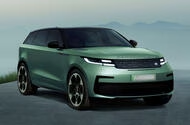The Range Rover Velar is gearing up for a significant transformation, set to debut as an electric vehicle (EV) that breaks away from its traditional SUV design. This next-gen model promises to blend sleek aesthetics with advanced technology, aiming to elevate its status in the luxury automotive market.
What’s Changing with the Velar?
The upcoming Velar will be a larger, lower-slung EV, moving away from the boxy SUV silhouette that has defined its predecessors. Instead, it will feature a more streamlined profile, merging characteristics of saloons and shooting brakes. This shift is not just about looks; it’s a strategic move to carve out a distinct identity within the Range Rover lineup, especially as it prepares to compete with other luxury electric models like the Porsche Macan Electric and BMW iX.
The Velar is currently undergoing rigorous testing, and early spy shots indicate that it will be longer than the existing model. This increase in size could potentially allow for a third row of seats, enhancing its appeal to families and those needing extra space. Additionally, the new design will see the Velar riding closer to the ground, reinforcing its image as a road-focused vehicle.
What’s Under the Hood?
The Velar will be the first model to utilize JLR’s new 800V EMA platform, specifically designed for electrified SUVs. This platform will also support future models like the next Evoque and a compact Defender variant. While details about the electric motors and battery systems are still under wraps, JLR is collaborating with Tata to develop batteries at a new facility in Somerset.
Interestingly, while the initial launch will focus on the electric version, there’s still a possibility for a combustion variant in the future. This flexibility is crucial as JLR responds to the evolving market dynamics and consumer preferences. The company has noted a surprising uptick in demand for plug-in hybrids, indicating that they’re keeping their options open.
How Will the Interior Look?
Inside, the Velar is expected to draw inspiration from the full-size Range Rover, emphasizing a minimalist, tech-centric layout. High-quality materials and advanced functionalities will be key to attracting buyers in competitive markets like the US, Middle East, and China. As luxury consumers become more discerning, the interior experience will play a pivotal role in the Velar’s success.
What’s the Bigger Picture for Range Rover?
The Velar’s redesign is part of a broader strategy to recalibrate the entire Range Rover lineup, which has been in the works for over 55 years. Following the Velar, we can expect the electric versions of the Range Rover and Range Rover Sport to hit the market, both of which will share production lines with their combustion counterparts. This transition is essential as key markets begin phasing out new combustion engine vehicles within the next decade.
JLR is committed to ensuring that their electric models deliver performance on par with their petrol-powered siblings. For instance, the upcoming Range Rover Electric is projected to match the performance of existing V8 models, thanks to innovations like an Intelligent Torque Management system that enhances traction and responsiveness.
What’s Next for the Velar?
As we await the official launch, which is anticipated around spring 2026, the Velar stands at the forefront of JLR’s ambitious plans. The company is not only looking to refresh the Velar’s image but also to boost its sales, which have lagged behind its competitors. With fewer than 24,000 units sold in the last year compared to the Evoque’s 44,000, the new Velar must make a strong impression to regain market traction.
The big takeaway? The new Range Rover Velar isn’t just about electrification—it’s about redefining luxury and performance in the EV space. Keep an eye on this model, as it could set the tone for the future of the entire Range Rover brand. Start with one change this week, and you’ll likely spot the difference by month’s end.

